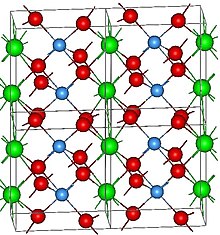Lutetium tantalate

Lutetium tantalate is a chemical compound of lutetium, tantalum and oxygen with the formula LuTaO4. With a density of 9.81 g/cm3,[1] this salt is the densest known white stable material. (Although thorium dioxide ThO2 is also white and has a higher density of 10 g/cm3, it is radioactively unstable; while not radioactive enough to make it unstable as a material, even its low rate of decay is still too much for certain uses such as phosphors for detecting ionising radiation.) The white color and high density of LuTaO4 make it ideal for phosphor applications, though the high cost of lutetium is a hindrance.[2][3]
Properties
Under
Lutetium tantalate itself is weakly
Preparation
To prepare a sample of lutetium tantalate, powders of lutetium and tantalum oxides (Lu2O3 and Ta2O5) are mixed and annealed at a temperature above 1,200 °C for several hours. To prepare a phosphor, a small fraction of appropriate material, such as an oxide of another rare-earth metal, is added to the mixture before annealing. After cooling, the product is leached with water, washed, filtered and dried, resulting in a white powder consisting of micrometre-sized particles of LuTaO4.[1]
References
- ^ .
- ISBN 0-8493-7560-6.
- ISBN 0-415-33340-7.
- .
- ISBN 3-540-23886-7.
